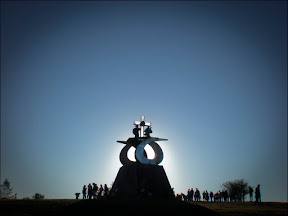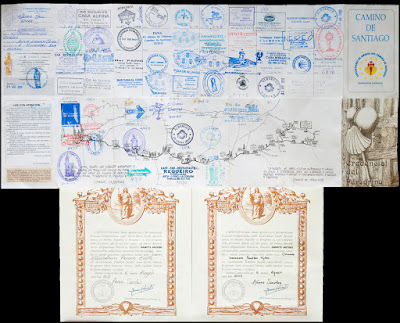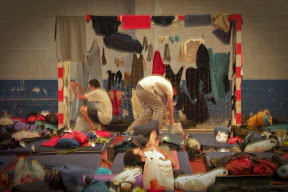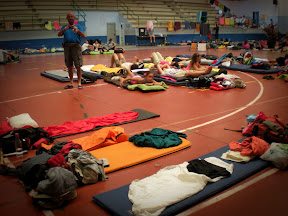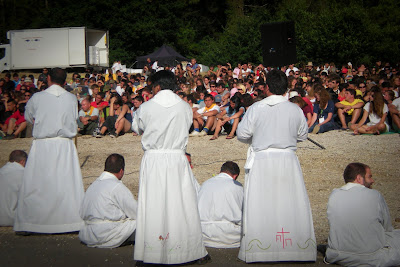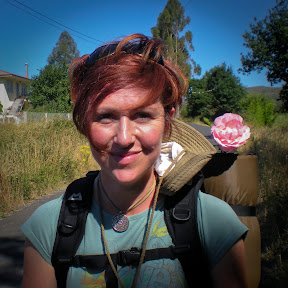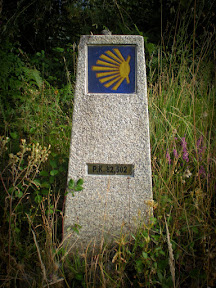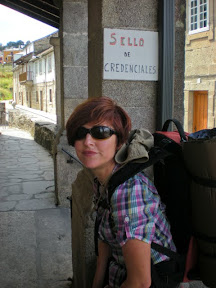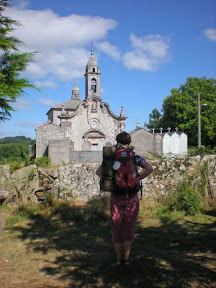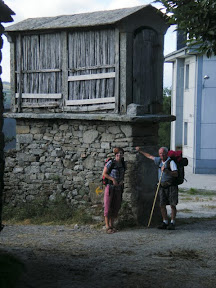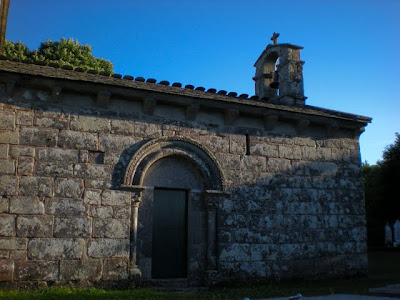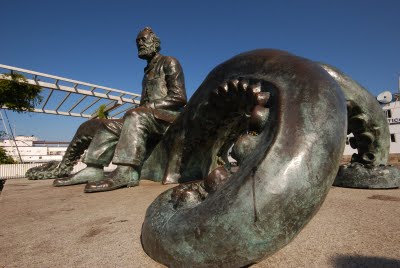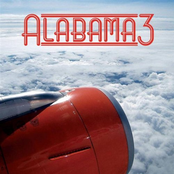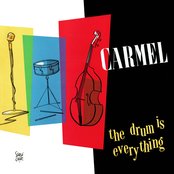Camino Primitivo, part 13: Monte de Gozo to Santiago de Compostela, 5km
With only 5km to go there was no rush. Even so, we had to be out of the albergue by 8am, at least, in theory… the day before I had seen folk leaving at 11 but they were Spanish and maybe there’s a constitutional right somewhere deep in the founding documentation of the country that gives them a lie in. We wandered up past the sculpture to grab a picture of it in the early sun and joined the flow of people all of whom wore satisfied smiles despite a lot of hobbling and limping along.
We stopped for breakfast, I wanted chocolate and churros, even though it was high summer… but the waitress told us that there was toast or toast no matter what the sign outside said, maybe there would be a pack of cake if she looked really hard. Not surprising becuase this was the first cafe on the way into town and there had been a lot of early risers, she looked tired and run off her feet.
The rest of the walking was urban, along main roads or into the city pretty quickly. The walkers grouped at red lights and the drivers of Santiago seemed to be unnaturally patient while these big groups crossed roads. The outskirts of the city were nothing to write home about, and we kept up a good pace to reach the old town. As we got nearer the buildings were lower, the streets narrower and we were struck by the numbers of youth marching around in gangs with matching t-shirts that proclaimed their part in the mass youth pilgrimage 2010. We passed one of the gates into the old centre of the city, into the narrow pedestrian streets, the signs pointing this way and that. We passed the back of the cathedral, the North entrance, which is where the pilgrims of old would enter the cathedral (and burn their clothes, both in a rite of purification and because they reeked like six month old fish no doubt). We continued past the lone piper (there is apparently only one place in the city where they let the pipers play every day, otherwise the citizens complain about the noise) and finally entered the plaza de obredorio, the famous square bounded by the cathedral, the university, the town hall and the fantastically luxurious hotel el hospital los reyes catolicos (The hospital of the catholic kings).
So, that was it. I can’t say I felt spiritually moved, or indeed moved very much at all, happy to finish a long walk, enjoying the experience of a new city but not any more than that (for me, at least, the walking was the sole reason to do it).
We sat and stood and took a few photos, admiring the lichen covered stone of the cathedral. Then we headed off to the pilgrim’s office to get our compostelas. These are the official certificates documenting your indulgence from Jimmy for having walked all the way to see him. The queue was pretty long, we waited an hour before a very nice English lady asked to see my credentials and filled in my name (in latin) on the certificate.
Certificates in hand, we went to find our emergency hotel, which turned out to be a basic, but very pleasant pensión, right in the centre. We went out to buy a couple of postcards, enjoying the lightness of foot that comes with not wearing a rucksack, and then went in search of the line to hug a saint.
2010 is a holy year, because saint James’ day is on a Sunday, the next one will be in 2021. The holy years are big business for the cathedral, they have a special door (imaginatively called the holy door) which is bricked up the rest of the time. Just as in Rome, they unbrick it for the holy years and grant indulgences to those who enter (that’s different to our certified indulgences which are good for a free pizza in the vatican, I think. Hey what do I know, we never really did catechism at school). So the queue for the holy door goes around the block. We queued.
When you go in you enter behind the main altar in the cathedral, the holy door is only for saint hugging, if you want to go to mass that’s another queue. You enter a small door in the ornate gilded rear part of the altar and follow some steps up until you’re directly behind the statue of saint Jim, and in our case, looking at the back of the bishop of somewhere as he said his mass to a packed audience. People hug the statue, from behind, like a “guess who”. Liz being game, and having experience of Rome, did the hugging thing. I refrained from patting him on the head and walked past. Then they direct you under the altar so you can walk past Santiago’s tomb, or more correctly, the box containing his remains (or even more correctly, the box containing some remains which are claimed to be those of saint Jim). He was a small chap, or there’s not much of him left. Then out into the hot sunlight, and all that remains is to find somewhere to eat and to figure out what to visit over the next two days.
Nos quedó 5km solo entonces no había prisa pero tuvimos que salir del albergue antes de las 8h, en teoría, el día anterior vi unas personas que salieron a las 11 pero eran Españoles y quizás hay una derecha constitucional que este muy dentro de la documentación de la fundación del país que las da la derecha de levantarse tarde. Paseamos por la escultura para sacar una foto en la luz de la mañana temprano, nos unimos con el corriente de gente que sonreían de satisfacción a pesar de cojear.
Hicimos una parada para desayunar, yo quería chocolate y churros aun que sea pleno verano, pero la camarera nos dijo que tenían pan tostado, o pan tostado no importaba que decía el cartel, quizás habría un bizcocho si ella buscara fijamente, no era una sorpresa porque este fue el primer bar en el camino hacia la ciudad y había muchos que se habían levantado pronto, la camarera parecía cansada y muy ocupada.
El resto del camino era urbano, tras carreteras principales y dentro de la ciudad en poco tiempo. Los peregrinos se agrupaban a los semáforos y los conductores de Santiago parecían pacientes de manera poco natural mientras esos grupos largos cruzaban. Los alrededores de la ciudad no eran notables, caminábamos con un buen ritmo para llegar al centro histórico. Cuando nos acercábamos, notábamos que los edificios tenían menos altura, las calles eran mas estrechas y nos llamaba atención que había un montón de jóvenes que iban en pandillas llevando camisetas idénticos que proclamaban sus participación en la peregrinación de la juventud 2010. Entramos en el centro antiguo de la ciudad por uno de los portales, por las calles estrechas y peatonales, vimos las señales que nos indicaban por todos lados. Pasamos por la parte atrás de la catedral, la entrada del norte, donde los peregrinos de antigüedad entraban en la catedral (y donde quemaban la ropa, como un rito de purificación y porque la ropa apestaban sin duda). Continuamos pasando por el gaitero (aparentemente había solo un lugar en la ciudad donde dejan tocar los gaiteros, sino los vecinos se quejan por el ruido) y al final entramos en la plaza de Obredorio, la plaza famosa rodeada por la catedral, la universidad, el ayuntamiento y el lujoso hospital de los reyes católicos.
Pues, se acabó. Yo no sentía nada espiritual, ni movido por nada más tampoco. Sentía feliz terminar un camino largo, disfrutaba la experiencia de una ciudad nueva pero nada más que eso (para mi, por lo menos, caminar es la única razón para hacerlo).
Nos sentamos, pusimos a pie, sacamos unas fotos, admiramos la piedra de la catedral cubierto de liquen. Fuimos a la oficina de los peregrinos para conseguir las compostelas, los certificados oficiales que documentan la indulgencia de Jaime por haber caminado a verle. La cola estaba bastante larga, esperamos una hora hasta que una señora inglesa y amable me pidió ver las credenciales y escribió mi nombre (en latín) en el certificado.
Con los documentos en las manos, fuimos a encontrar el hotel de emergencia que resultó una pensión básica, bonita y céntrica. Salimos para comprar unos postales, lo disfrutamos el sentimiento de ligereza que venía de no llevar la mochila, después buscamos la cola de abrazar un santo.
2010 es un año santo, porque el día de Santiago cae en un domingo, el próximo será 2021. Los años santos son un buen negocio para la catedral, hay un portal (que se llaman la puerta santa, con una imaginación impresionante) que esta cerrado con ladrillos en otros años. Igual que en Roma, la se abran para el año santo y dan indulgencias a los que entran (son diferentes a nuestras indulgencias certificadas con que nos dan una pizza gratis en el vaticano, pienso, que sé yo, no estudiamos el catecismo en la escuela). Por eso la cola es normalmente muy larga. Hicimos cola.
Entras detrás del altar principal, la puerta santa es solo para abrazar el santo, si quieres ir a misa hay otra cola. Entras una puerta pequeña en la parte de atrás del altar dorado, subes por unas escaleras hasta que estas detrás de la estatua de Santo Jaime, y en nuestro caso, estas mirando a la espalda del obispo de no sé donde mientras el esta celebrando la misa para mucha gente. La gente abraza la estatua desde atrás (como si fuera un juego de ¿quién es?). Liz, que se apunta a todo, y tener experiencia de Roma, le abrazó. Me abstuve de darle a el unas palmaditas en la cabeza y le pase. Después te dirigen debajo del altar para que pases por la tumba de Santiago, o mas bien dicho la caja en que quedan sus restos (o aun mejor dicho la caja que contiene unos restos que se afirman son del santo Jaime). Era un hombre pequeño, o no queda mucho de el. Después afuera en la luz calurosa y lo único que nos queda es encontrar un lugar para comer y decidir que visitar en los dos días siguientes.
Tags: camino primitivo, galicia, Spanish and English, walking
Posted in spain Comments Off
